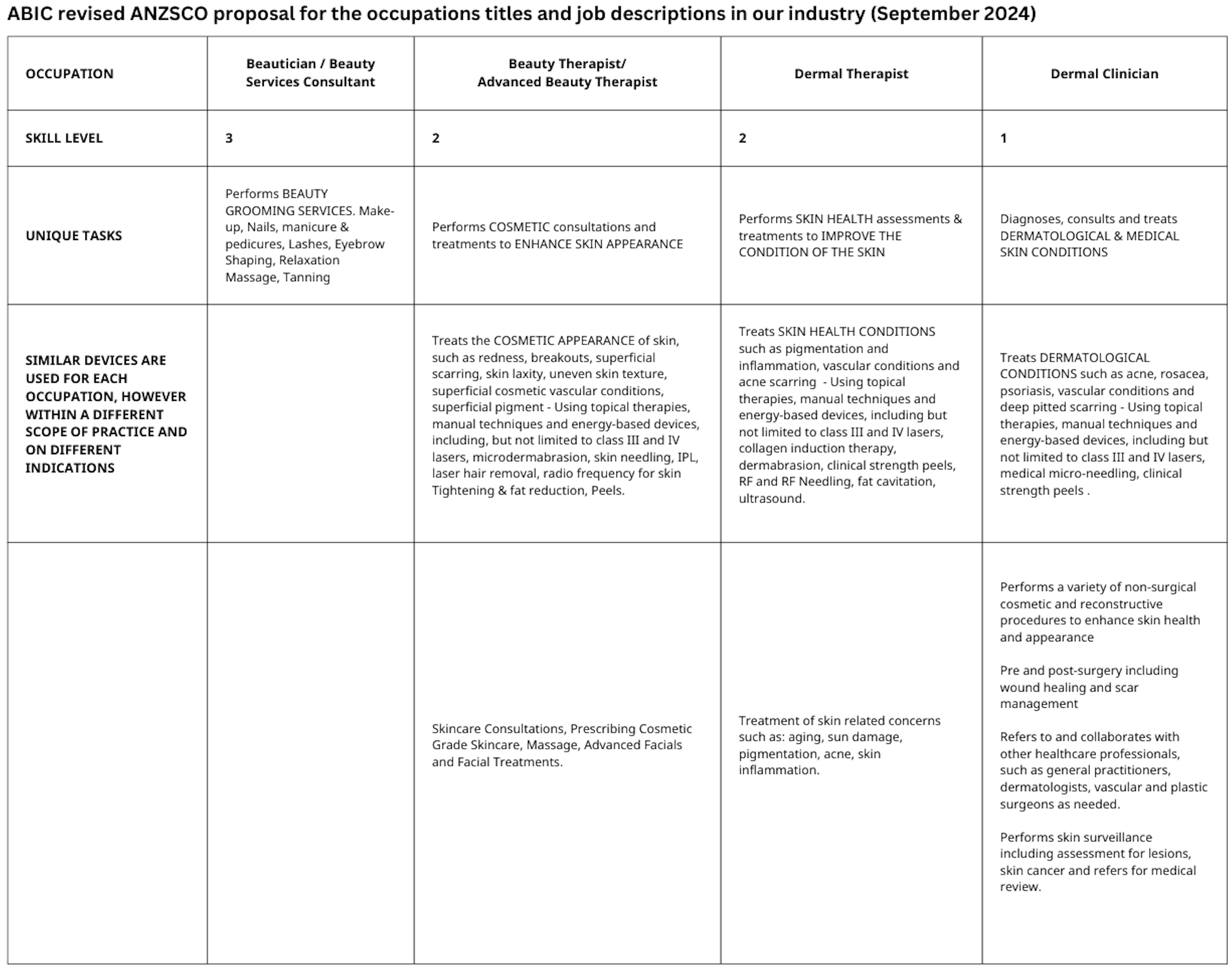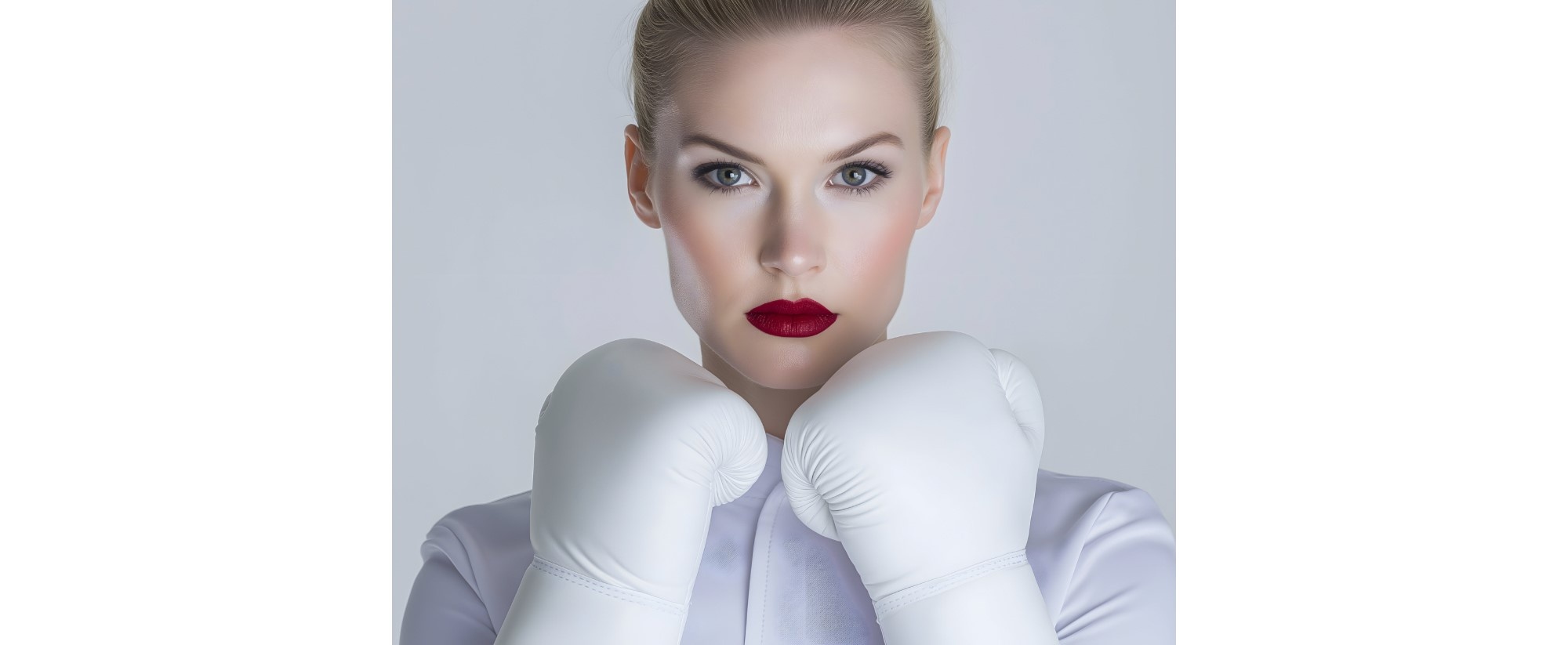As the Australian Bureau of Statistics (ABS) embarks on a once in 20 years comprehensive review of the Australian and New Zealand Standard Classification of Occupations (ANZSCO), significant and paramount changes are on the horizon for the beauty and dermal industry.
The review aims to modernise the classification system to better reflect the evolving landscape of various professions, including those within the beauty and aesthetics sectors.
This update is now a critical juncture for our industry and its professionals, as it will influence and change the scope of practice, qualifications, and professional identities within our community.
It is moments like this that define why we need a unified peak body to represent us, and why the number of members we represent to Government are so important.
I urge you to please review this information, get informed and have your say:
1. Read an article explaining the current ANZSCO Review - CLICK HERE
2. Watch a video recording of an ANZSCO Information Meeting, and share it! - CLICK HERE
Passcode Below: l0Ei3U*@
3. Read the attached PDF of the information session pertaining to the ANZSCO Information Meeting >> ANZSCO REVIEW PRESENTATION.pdf
4. Continue reading below for a summary of the review and what we need from you!
SUMMARY
The ANZSCO review is an update and evaluation process of the Australian and New Zealand Standard Classification of Occupations by the ABS, aimed at ensuring the classification system accurately reflects current job roles, skills, and labour market needs.
Getting the ANZSCO review for Beauty, Dermal and Aesthetic Occupations right is crucial because it directly impacts workforce planning, immigration policies, education and training programs, and the alignment of skills with industry needs, in addition to regulation and legislation pertaining to our industry.
ABIC have been involved in every stage of the process and have previously submitted a plan that exactly reflected our current occupations and skill levels. We are now at what the ABS call Stage 4 Consultation.
CURRENT ABS BEAUTY INDUSTRY OCCUPATION
The ABS currently only have one occupation listed in our industry.
Beauty Therapist – Skill Level: 3 – Quals: Certificate 3 & 4 – These are the qualifications for Beauty Services / Beautician, not Beauty Therapist.
Therefore, this classification is incorrect.
The ABS do not currently recognise those with a Beauty Therapy Diploma as having a sperate occupation.
The ABS do not currently recognise Dermal Therapists or Dermal Clinician occupations.
**OLD 2023** ABIC PROPOSED OCCUPATIONS TO ABS
As part of the early stages of the review, ABIC have previously requested 5 New / Reclassified) Occupations, so that government clearly understands our industry landscape:
This is the main part of our submitted proposal:
Occupations:
Beauty Services / Beautician Skill Level 3
Beauty Therapist Skill Level 2
Dermal Therapist Skill Level 1 or 2 (Based on AQF Level)
Dermal Clinician Skill Level 1
Cosmetic Nurse Skill Level 1
Descriptions:
|
Occupation |
Beauty Services Consultant |
Beauty Therapist |
Dermal Therapist |
Dermal Clinician |
Cosmetic Nurse |
||
|
Skill Level |
3 |
2 |
2 |
1 |
1 |
||
|
Unique Tasks |
Make-up
Nails, manicure & pedicures
Lashes
Eyebrow Shaping
Relaxation massage
Tanning
|
Massage
Facials
Use of superficial beauty devices such as microdermabrasion, skin needling, IPL, Laser Hair Removal , Radio Frequency
Skincare consultations
Skincare
|
Skin Condition Assessment & treatment planning
Treatment of Ageing, sun damage, pigmentation, acne, skin inflammation
Treatment of mild scarring, and superficial acne scarring
Use of more intensive medical grade and beauty devices such as microdermabrasion, skin needling, IPL, Laser Hair Removal , Radio Frequency, fat freezing, ultrasound
|
|
Administers Injectable treatments such as anti-wrinkle injections, dermal fillers
Performs thread lift procedures using mini threads
Administers PRP procedures
Is able to perform skin resurfacing procedures, using ablative or fractional lasers
|
This proposal has not been entirely accepted.
ABS PROPOSED OCCUPATIONS
The ABS have proposed 2 occupations:
451112 Beautician / Beauty Therapist – Skill Level 3
Description: Provides skin care, beauty and body treatments to clients. Make Up Artists and Body Artists are excluded from this occupation.
Main Tasks: • Performs a range of beauty treatments, such as facials, spray tanning, eyebrow shaping and waxing • Administers body treatments, such as massages, body wraps and scrubs • Conducts skin analyses to determine clients’ skin type and condition and uses superficial beauty devices to treat clients’ skin • Advises on skincare routines and sells beauty products to clients • Maintains a clean and hygienic work area and sterilises equipment in adherence to health regulations • May apply artificial beauty products such as nails or eyelashes • May perform cosmetic tattooing to clients Specialisations: • Cosmetic Tattooist • Eyelash Technician • Manicurist • Nail Technician
451113 Dermal Therapist – Skill Level 2
Description: Performs treatments to maintain and enhance overall skin appearance.
Main Tasks: • Completes skin analysis and assessment to determine appropriate treatments for clients • Applies various dermal therapy treatments for skin rejuvenation, age management and acne treatments such as microdermabrasion and cosmetic grade peels • Uses laser and intense pulsed light devices for hair reduction treatment • Provides non-invasive, superficial treatment of pigment and superficial vessels (telangiectasias) • Perform a variety of non-surgical procedures within their scope to enhance skin appearance • Provides advice to clients on skincare and maintenance, including product recommendation
ABIC believe both of these occupations, the way they are listed, are not reflective of the current industry occupations.
SEE THE ABS ANZSCO PROPOSAL - Scroll to Page 8 for Beauty
AUGUST 2024 - DRAFT OF ABIC PROPOSED OCCUPATIONS (SEPT NOW REVISED BELOW)
An ABIC survey was conducted to gather feedback from our members and industry regarding the below AUGUST Proposal.
We now have a refined proposal below, dated 4th Sept 2024. Based on approx. 700 of your submissions to ABIC.

WHAT WE DID
- ABIC called for member feedback in 2023 for the first stage of the Personal Services ANZSCO Occupations Review for our industry.
- We submitted a proposal to the ABS on behalf of our industry in Dec 2023.
- After receiving Stage 4 notification of the revised ANZSCO proposal at the end of July 2024, we sought member and then industry feedback throughout late July and August 2024 regarding a revised proposal.
- ABIC held an industry meeting to explain and inform regarding the ANZSCO Occupations Review which was immediately released to the industry and public for their information.
- After conducting and awareness campaign, we released a survey to gather your feedback.
- ABIC then carefully disseminated the feedback and information you presented to us.
- We then presented the full survey report with all of your feedback to the independent members of ABIC Self-Regulation Committee in a formal meeting held on the 4th September.
(The self-regulation committee is made up of industry stakeholders and is open for application to the industry. Learn more HERE )
- The self-regulation committee was tasked to refine the proposal based on your feedback and create a semi-final proposal.
- The semi-final proposal is currently undergoing final review by the ABIC Council, and other aligned peak bodies and government aligned organisations such as The Australian Society of Dermal Clinicians and SACSA.
- We have released that below to the industry and public.
- The final proposal will be sent to the ABS on Friday 6th September 2024, along side SACSA's proposal.
- We will await feedback from the ABS.
- Should we feel that their final review is not aligned with industry, we will appeal.
SEPTEMBER 2024 - SEMI-FINAL ABIC PROPOSED OCCUPATIONS

WHAT ABIC NEED FROM YOU
- ABIC has put forward a proposal based on your feedback and votes.
- We appreciate your patience while we all wait for the ABS to review and decide.
- No matter the outcome, we are proud that our industry has come together to have a voice.
- In the industry there are many different opinions, not everyone will be happy with the outcome, whatever the result.
- So, it is important not to sit in judgment or spread negativity regarding any occupation, qualification, any peak body in our industry, or any of the generous people associated with any peak body that have dedicated their time to represent your voices.
- The more numbers we have united, the stronger and more accurate our representation to government will be.
- So if you are not a member of ABIC, join together with thousands in the industry and together we will continue to make a difference.
Thank you for your voices as we continue “Fighting For Our Industry & Protecting Your Future”



